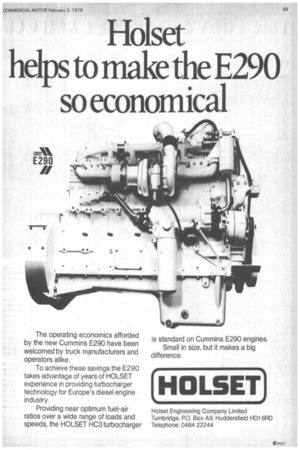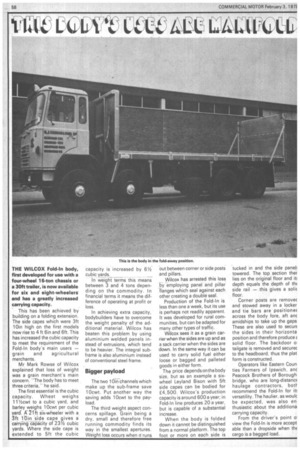Holset helps to make the E290 so economical
Page 61

Page 60

If you've noticed an error in this article please click here to report it so we can fix it.
THE WILCOX Fold-In body, first developed for use with a four-wheel 16-ton chassis or a 30ft trailer, is now available for six and eight-wheelers' and has a greatly increased carrying capacity.
This has been achieved by building on a folding extension. The side capes which were 3ft 10in high on the first models now rise to 4 ft 6in and 6ft. This has increased the cubic capacity to meet the requirement of the Fold-In body's main users — grain and agricultural merchants.
Mr Mark Rowse of Wilcox explained that loss of weight was a grain merchant's main concern. "The body has to meet three criteria,'" he said.
The first essential is the cubic capacity. Wheat weighs 111/2cwt to a cubic yard, and barley weighs lOcwt per cubic yard. X 2-tft six-wheeler with a aft lbin side cape gives a cairYii4EaNcity of 231/2 cubic yards. Where the side cape is extended to 5ft the cubic capacity is increased by 61/2 cubic yards.
In weight terms this means between 3 and 4 tons depending on the commodity. In financial terms it means the difference of operating at profit or loss.
In achieving extra capacity, bodybuilders have to overcome the weight penalty of the additional material. Wilcox has beaten this problem by using aluminium welded panels instead of extrusions, which tend to be heavier. The integral subframe is also aluminium instead of conventional steel frame.
Bigger payload
The two 10in channels which make up the sub-frame save 10cwt. Put another way the saving adds 10cwt to the payload.
The third weight aspect concerns spillage. Grain being a dry, small and therefore free running commodity finds its way in the smallest apertures. Weight loss occurs when it runs Out between corner or side posts and pillars.
Wilcox has arrested this loss by employing panel and pillar -flanges which seal against each other creating a double seal.
Production of the Fold-In is less than one a week, but its use is perhaps not readily apparent. It was developed for rural communities, but can be adapted for many other types of traffic.
Wilcox sees it as a grain carrier when the sides are up and as a sack carrier when the sides are down. In the same way it can be used to carry solid fuel either loose or bagged and palleted goods in either form.
The price depends on the body size, but as an example a sixwheel Leyland Bison with 5ft side capes can be bodied for £4,500. Wilcox's production capacity is around 600 a year; in Fold-In line produces 20 a year, but is capable of a substantial increase.
When the body is folded down it cannot be distinguished from a normal platform. The top foot or more on each side is tucked in and the side panel! towered. The top section ther lies on the original floor and iu depth equals the depth of the side rail — this gives a solic floor.
Corner posts are removec and stowed away in a locker and tie bars are positionec across the body fore, aft anc amidships to take up the gaps These are also used to secure the sides in their horizonta position and therefore produce E solid floor. The backdoor 01 tailgate is removed and securec to the headboard, thus the plat form is constructed.
Operators like Eastern Coun ties Farmers of Ipswich, anc Peacock Brothers of Borough bridge, who are long-distancE haulage contractors, botlrecommend the Fold-In for it versatility. The haulier, as woulc be expected, was also en. thusiastic about the additiona carrying capacity.
From the driver's point cr view the Fold-In is more accept able than a dropside when thE cargo is a bagged load,
























































































































































